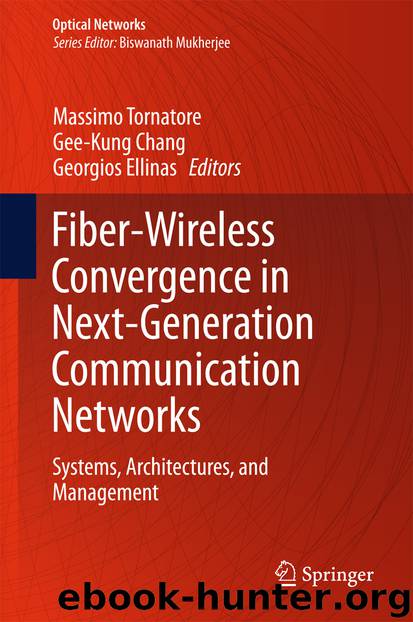Fiber-Wireless Convergence in Next-Generation Communication Networks by Massimo Tornatore Gee-Kung Chang & Georgios Ellinas

Author:Massimo Tornatore, Gee-Kung Chang & Georgios Ellinas
Language: eng
Format: epub
Publisher: Springer International Publishing, Cham
7.3.1 SDN-Based Control in Fiber Wireless Networks
It is noted that the technology-agnostic nature of SDN is quite important in SDN applications to fiber wireless networks since they can rely on a plethora of underlying fixed network topologies and technologies, including more and more prominently, optical access networks [27–29]. In the optical access networks context, however, there exists a tendency to equate this networking segment with PONs deployed for residential services. However, if optical access is equated only with PON, the first thought on the matter might be that SDN may not be needed for a variety of reasons. First, in certain cases, the PON might be a single domain, single operator, often single vendor network that is too small for SDN to make a significant impact. Secondly, there may not always be a need for network abstraction/virtualization as the underlying services often tend to be homogeneous. For Ethernet-based bit stream services, for example, there may not be an urgent need to differentiate between data flows beyond what is already done in legacy PON. And finally, in legacy PONs, there is no out-of-band control plane with north/south-bound management interfaces to remote optical network units (ONUs).
On the other hand, it can be argued that even if optical access networks are circumscribed to legacy PON, SDN can still introduce valuable benefits into the network, by evolving the degree of programmability in both the optical line terminal (OLT) and the ONUs beyond what is achievable with legacy management and protocols. As an example, it is noted that conventional ONUs do not support the dynamic modification of the high-level network policy that determines how incoming data flows are mapped to logical connections. Instead, these mapping rules are hard-coded and vendor proprietary. Introducing the capability for programmable modification of these rules and policies as a service and implementing it through an open, vendor-agnostic interface such as OpenFlow could create new revenue streams in PON-based fiber wireless networks. Specifically, since legacy PON technologies already provide quality-of-service (QoS) support by mapping incoming flows into queues, it becomes possible to exploit SDN to map traffic into specific service classes at the OLT and ONU ports, effectively treating the OLT and ONUs of the PON as the backplane of a distributed SDN switch. The resulting data flow differentiation can be attractive across customer verticals including content providers, mobile operators, as well as enterprise and residential customers, and has no dependence on underlying PON technology type. It would, however, require a physically separate control plane. To implement this, exploiting existing centralized OLT-side control that governs ONU bandwidth allocation and management, and extending existing mechanisms, such as the ONU management and control interface (OMCI), could be a promising approach.
Moreover, a more broad future-oriented perspective can also be adopted under which optical access is not equated only to PON, but is regarded as the short-reach optical network infrastructure that will increasingly be needed to handle new traffic types, particularly from mobile applications. Recent trends of short-reach fiber-optic connections to a highly diverse set
Download
This site does not store any files on its server. We only index and link to content provided by other sites. Please contact the content providers to delete copyright contents if any and email us, we'll remove relevant links or contents immediately.
| Automotive | Engineering |
| Transportation |
Whiskies Galore by Ian Buxton(41880)
Introduction to Aircraft Design (Cambridge Aerospace Series) by John P. Fielding(33064)
Small Unmanned Fixed-wing Aircraft Design by Andrew J. Keane Andras Sobester James P. Scanlan & András Sóbester & James P. Scanlan(32743)
Craft Beer for the Homebrewer by Michael Agnew(18140)
Turbulence by E. J. Noyes(7936)
The Complete Stick Figure Physics Tutorials by Allen Sarah(7307)
Kaplan MCAT General Chemistry Review by Kaplan(6867)
The Thirst by Nesbo Jo(6828)
Bad Blood by John Carreyrou(6552)
Modelling of Convective Heat and Mass Transfer in Rotating Flows by Igor V. Shevchuk(6391)
Learning SQL by Alan Beaulieu(6211)
Weapons of Math Destruction by Cathy O'Neil(6146)
Man-made Catastrophes and Risk Information Concealment by Dmitry Chernov & Didier Sornette(5921)
Digital Minimalism by Cal Newport;(5664)
Life 3.0: Being Human in the Age of Artificial Intelligence by Tegmark Max(5474)
iGen by Jean M. Twenge(5366)
Secrets of Antigravity Propulsion: Tesla, UFOs, and Classified Aerospace Technology by Ph.D. Paul A. Laviolette(5309)
Design of Trajectory Optimization Approach for Space Maneuver Vehicle Skip Entry Problems by Runqi Chai & Al Savvaris & Antonios Tsourdos & Senchun Chai(5011)
Pale Blue Dot by Carl Sagan(4912)
